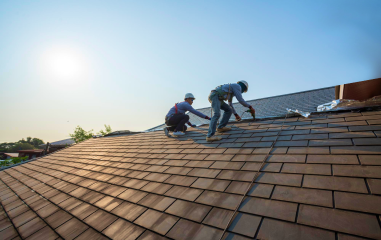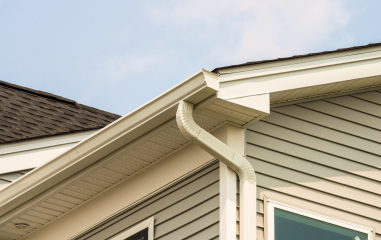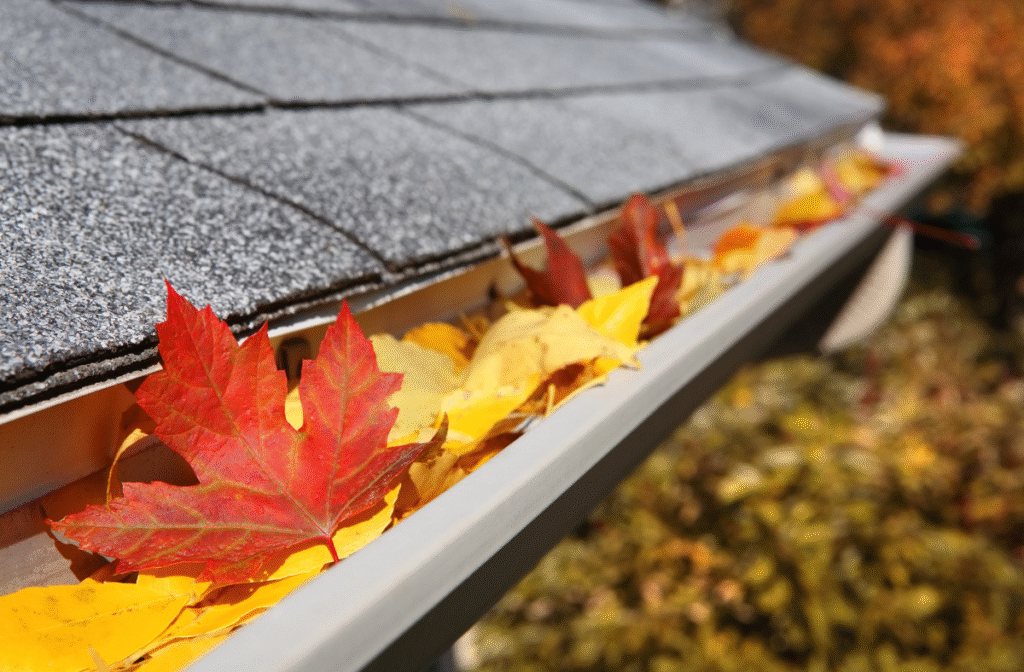As the long, hot summer winds down, fall brings a welcome change. You get cooler weather, colorful leaves, and a great opportunity to give your roof the attention it deserves.
After months of heat, storms, and heavy rain, your roof has worked hard protecting your home. Fall is the perfect time to make sure it’s ready for winter’s wind and rain.
A few hours of fall roof maintenance now can save you thousands of dollars in repairs later. Regular roof upkeep not only extends the lifespan of your roof but also prevents leaks, improves energy efficiency, and keeps your home comfortable year-round.
Here’s how to take care of your roof this fall and get it ready for the months ahead.
Table of Contents
Need to repair or replace your roof? Give us a call for FREE roof inspection
Why Fall Roof Maintenance Matters in Texas
Texas weather is unpredictable. Summer’s blazing sun and frequent thunderstorms can take a toll on shingles, flashing, and gutters. Then, as temperatures start to drop, the materials on your roof expand and contract, putting stress on joints and sealants.
By checking your roof in the fall, you can find and fix small issues before they turn into leaks or costly roof damage. A little fall roof maintenance now helps your roof handle whatever winter brings, whether it’s cold rain, gusty winds, or the occasional freeze.
(Note: For safety reasons, we don’t recommend climbing onto your roof. Perform what maintenance you can with a ladder and let the professionals go onto your roof.)
Clean and Inspect Your Gutters
When the leaves start to fall, your gutters are the first place they end up. Clogged gutters can cause serious problems, especially during heavy rains. Water that can’t flow through properly backs up onto your roof and under your shingles, leading to leaks and rotted fascia boards.
Take time this fall to clear out leaves, twigs, and debris from your gutters and downspouts. Flush them with a hose to make sure water flows freely. While you’re at it, check for sagging or detached sections that could cause overflow.
If you notice that your gutters frequently clog, consider installing gutter guards. They reduce maintenance and protect your roof from water damage.
Check Shingles and Flashing for Damage
Your shingles are your roof’s first line of defense against the elements. Over time, high temperatures, UV rays, and summer storms can weaken them. Damaged shingles often lead to leaks once fall rainstorms arrive.
Stand back and look at your roof from the ground to see if any shingles are missing, cracked, or curling. Check for dark patches where granules may have worn away, which can indicate aging or hail damage to your roof.
Flashing, the thin metal strips that seal roof edges and around chimneys or vents, is another key area to inspect. Loose or rusted flashing can let water seep under shingles.
If you’re unsure about what you’re seeing, call a professional. M&M Roofing, Siding, and Windows offers FREE roof inspections and can spot damage that isn’t visible from the ground. It’s safer, faster, and ensures you don’t miss early warning signs of trouble.
Inspect Roof Valleys and Eaves
Roof valleys are the V-shaped areas where two roof slopes meet. Because they channel water off the roof, they’re also one of the first places debris collects. Leaves, branches, and dirt in these valleys can trap moisture, leading to rot and leaks.
Eaves—the overhanging edges of your roof—are also vulnerable to moisture and pests. Check for signs of water stains, mildew, or soft wood. Make sure water flows away from these areas and that the fascia boards are in good shape.
Keeping valleys and eaves clear ensures proper drainage and helps prevent leaks when the next storm rolls through.
Trim Overhanging Tree Branches
Those big oak and pecan trees that provide shade in summer can become a hazard in the fall and winter. Overhanging branches drop leaves, scrape against shingles, and even break off during high winds. All of this increases the chance of roof damage.
Trim back any branches that hang over your roof, ideally leaving a six- to ten-foot clearance. This keeps leaves from piling up in valleys and gutters and helps prevent damage during storms.
Trimming also deters squirrels and raccoons from accessing your roof and causing additional problems like chewed vents or torn shingles.

Check Attic Ventilation and Insulation
Proper ventilation is one of the most overlooked parts of roof maintenance. Without good airflow, moisture builds up inside your attic, leading to mold, warped decking, and even premature shingle failure.
Go into your attic and look for signs of trouble: musty odors, damp insulation, or condensation on rafters. Make sure vents are clear of debris, and insulation isn’t blocking airflow.
While you’re there, check your insulation levels. Good insulation keeps warm air from escaping, reducing your energy bills during cooler months. If your attic feels drafty or too warm, it may be time for an upgrade.
Look for Signs of Leaks Inside Your Home
Roof problems don’t always start outside. Take a few minutes to inspect your ceilings and upper walls inside your home. Look for water stains, discoloration, peeling paint, or sagging drywall. These are signs that moisture is getting through your roof.
Check your attic for wet insulation, damp wood, or moldy odors. Even a small leak can spread quickly once the weather turns colder and wetter.
Finding leaks early can mean the difference between a simple patch and major structural repairs. If you spot any signs of moisture, schedule a professional inspection immediately.
Schedule a Professional Roof Inspection
While there’s plenty homeowners can do on their own, some problems are only visible to a trained eye. A professional roof inspection provides a detailed look at your roof’s overall health.
An experienced roofer can detect issues like soft decking, hidden leaks, loose flashing, or granule loss that aren’t obvious from the ground. They’ll also assess whether your roof needs repairs or to be replaced.
Regular inspections help extend your roof’s life and ensure your roof warranty and insurance coverage remain valid.
Consider Preventive Repairs or Maintenance Upgrades
Once your roof has been inspected, take care of any recommended repairs right away. Fall is an ideal time for small upgrades that make your home more resilient and efficient before the colder months.
This could include replacing worn shingles, resealing flashing, repairing minor leaks, or adding gutter guards to reduce maintenance. In some cases, applying a reflective roof coating can also improve your home’s energy efficiency.
These proactive steps help prevent costly emergencies during winter storms when repair schedules fill up quickly.
We Can Help
At M&M Roofing, Siding, and Windows, we’ve been helping Texas homeowners protect their homes for more than 40 years. We understand the unique challenges that come with our state’s extreme weather, from intense summer heat to unpredictable fall storms.
Our free roof inspections are designed to give homeowners peace of mind. We’ll check your shingles, flashing, gutters, and ventilation, identify any weak spots, and make honest recommendations for maintenance or repair.
If we find damage, we’ll document it with photos and explain your options clearly. Whether it’s a simple repair or help filing an insurance claim, our goal is to make the process as smooth as possible.
Now is the perfect time to schedule your fall roof inspection. Taking care of your roof today means fewer surprises and lower costs tomorrow.
Final Thoughts: Prepare Now, Protect Your Home All Winter
Your roof works hard all year, but fall is your chance to return the favor. A few simple maintenance steps can protect your home from leaks, rot, and costly repairs during the months ahead.
By cleaning gutters, checking shingles, trimming trees, and scheduling a professional inspection, you’re investing in your home’s longevity and your peace of mind.fall
M&M Roofing, Siding, and Windows has been serving Texas homeowners for over 40 years. Call us or complete the request form to schedule a FREE roof inspection and consultation.


















